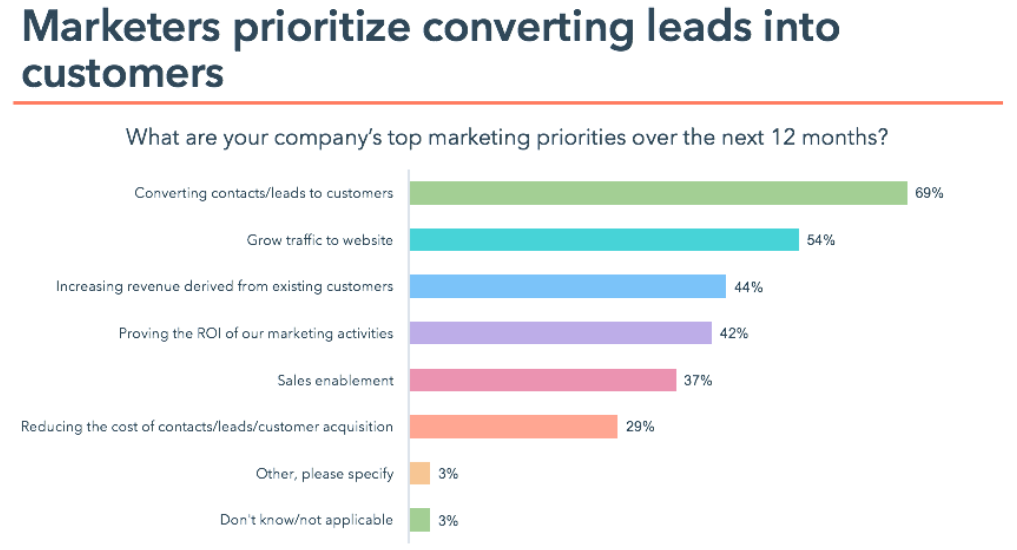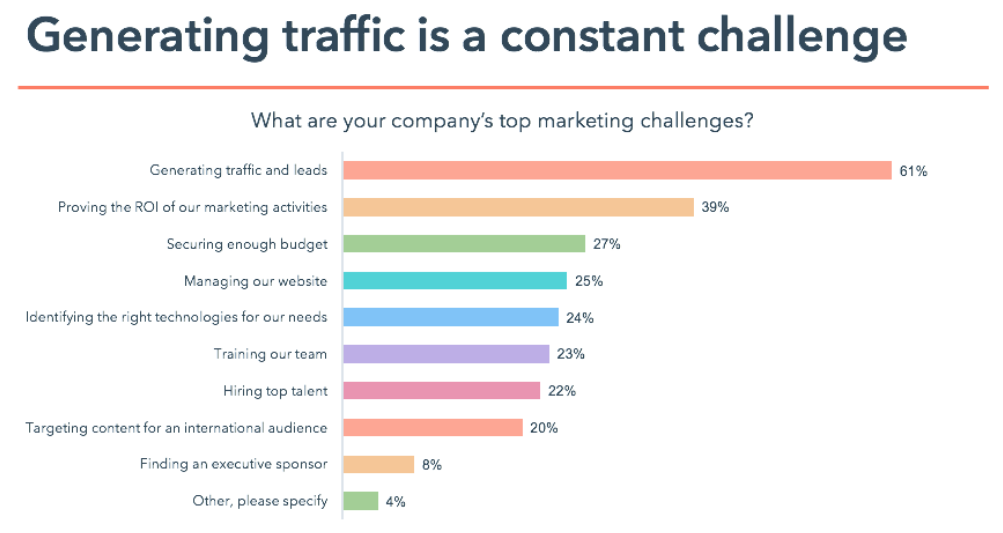Implementation of your plan is typically a marathon not a sprint

HubSpot recently issued their “State of Inbound 2018” Report. This annual report asks respondents what their company’s top marketing priorities will be over the next 12 months. 6200 respondents in 99 countries from a mix of industries, company sizes and levels of seniority weighed in, determining that customer conversion and website traffic growth were their overwhelming priorities. In fact, 69% of marketers prioritized converting leads into customers as their #1 marketing priority:

When it comes to marketing challenges, 61% of the respondents said generating traffic and leads was their #1 challenge:

1. Who are your primary customers?

To ensure you drive in qualified leads, you first need to draw accurate customer profiles (aka personas) of the lead type you require. Identify all the demographic information and significant data points you have at your disposal, including: age, gender, geo, annual purchase, type of purchase, customer profitability, origination, etc. If you’re struggling with this exercise, look at your present customer base where you should be able to identify your primary (‘A’) customer. Not only that, while identifying your primary customer, you will also be able to identify your ‘B’ and ‘C’ customers as well.
2. How many leads will it take?

In order to formulate your budget requirements, and to understand the extent of your marketing campaign, you need to calculate the amount of leads required to be placed in the customer conversion process. This understanding comes from an extrapolation of how many leads it takes to convert one customer. If you’re looking to acquire 100 new primary customers this year, and your conversion rate is averaging 10%, you’ll need approximately 10X that amount to reach your overall objective, i.e., 1,000 leads = 100 new primary customers. (If you’re wondering how you can increase that conversion rate, you’re in the same boat as the 69% of marketers who made it their marketing priority this year. More on this highly important factor in my next post).
I recommend you conduct an online search for a sales pipeline calculator to assist you in calculating your needs. You’ll find an abundance of calculators out there.
3. How will you acquire these new, primary customers?

This is key to understanding the best marketing tactics you need to employ. When you look at your present customer profiles, where are your customers originating? As an example, are they coming from referral sources, is it an Adwords lead, are you using email lists to reach out, (of course, it is probably all of the above, however, in order to prioritize your marketing tactics, you need to place emphasis on one of the other – or more likely, a combination of tactics).
4. Test, Test, Test.

If you don’t know which marketing tactics are acquiring your primary customers, it’s time to test your way through the many available digital tactics. Narrowing this extensive field of tactics can best be assisted by calling in the experts (like us), to add our experience to the conversation.
The next step is setting up tests to determine what can work best for you, and testing is a step you cannot miss as it is critical to ensure you can a) reach your acquisition goals, and b) your budget is used wisely. While the experts should help make the cost of testing more affordable, testing is nonethless, a key component.
5. Implementing the Marketing Plan.

So, when should you launch your marketing campaign, and is there a time to heighten or lower your marketing investment? Timing is critical of course, but most businesses have a decent handle on when is the most appropriate timing to reach a prospect. In the case of insurance, for instance, 30-90 days prior to policy renewal is a key decision-making time. However, if your type of commodity or service is high value and more complex to understand, the lead times will likely be much extended.
Understanding these factors is critical to appropriating your budget in the best possible way in order to make impact at decision making times. However, experience has always taught me that heightening your emphasis and spend at peak decision-making times is the correct approach, versus increasing your marketing efforts when the market is at low ebb.
6. Ensuring your marketing and sales efforts are in tune.

Implementation of your plan is where your marketing and sales efforts have to integrate at the highest levels, as one doesn’t exist without support from the other. Ask yourself:
- Is the sales team totally on-side with the program marketing is proposing?
- Does the sales team possess the knowledge and training to support the lead generation effort?
- Has marketing provided sales with the support programs they need to help them close the sale: website content, physical brochures, email letters, powerpoint presentations, trade show activities?
- Does the sales team have decent technology support in the form of a CRM system to manage the lead from prospect to conversion?
- Are you ready to have regular sales/marketing ‘pow wows’ to ensure all is on track, or to determine what needs to be tweaked along the way?
Awesome research fact: According to HubSpot, companies that align their sales and marketing see an average 20% annual revenue growth, as opposed to the 4% at firms where teams don’t work together.
7. Introducing the plan.

Now it’s time to call an “all hands on deck” meeting and introduce your entire team to the exciting plan you are about to introduce – and to make everyone a key part of this important effort.
And remember, you may personally introduce the plan and its objectives to your entire team, but your marketing and sales team leaders need to step up and present their portions and explain their responsibilities. By so doing, they are openly accepting responsibility for its success, in front of their peers.
8. Managing the plan.

Now it’s time to keep a close watch on the implementation of the plan. At the beginning, daily meetings with marketing and sales will help you keep your eyes on the ball. It is imperative that you remain close to the results in order to understand what needs to be changed, tweaked, added or taken away. Do it quickly. There’s an objective to be reached.
9. Celebrating success.

This is so important. Do it however it best works for you…prizes, cash, recognition plaques and awards. And make sure success is broadcast throughout your entire organization – even to your clients.
I’m going to focus my next post on the ‘conversion to lead’ priority identified by a huge number of respondents to this report. In particular, I will discuss some techniques that will help increase the all-important conversion rate.
In the meantime, good luck in your marketing efforts and call us in when you need our expert assistance. Initial discussions with us are always complimentary.
Sources: HubSpot “State of Inbound” 2018 Report and Sales & Marketing Alignment.
